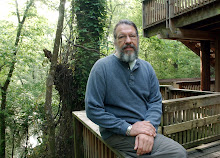Nelson's Sparrow -- note intricate patterning....handsome devils!
(photo by Jeff Trahan)
Finding a Nelson's Sparrow anywhere away from its isolated breeding and wintering grounds is a pretty big deal, as this bird tends to stick to marshland habitats even during migration.
Back in 1938 (from The Bird Life of Louisiana) when there were precious few non-game-bird observers living in Louisiana, ornithologist Harry Oberholser characterized this species as “a rare winter resident...in the Gulf Coast region of Louisiana,” and at that time was not aware of any Nelson's Sparrow sightings away from coastal marshes. By 1974 (see Louisiana Birds) ornithologist George Lowery, Jr. had realized that Nelson's Sparrow was actually common during winter throughout our coastal marshes; but reported only a handful of records away from the coast – only two of which came from the northern half of the state (“at Shreveport” in October 1963 and “at Natchitoches” -- probably from the state fish hatchery -- in December 1972). Even today, if you want to see a Nelson's Sparrow, you'll probably need to hang out around cattail marshes as near to the coast as possible – in winter of course. You gotta work for this one, ya'll.
Nelson's Sparrow -- Red River NWR 28 Sept 2011
(photo by Jeff Trahan)
Davis and Trahan noted that their Nelson's Sparrows were actually feeding on the seeds of a small unidentified weed species. Fortunately, Jeff got a bird/plant photo, which he forwarded to me. Like Jeff and Terry, I had no clue as to the identity of the plant, so I forwarded the photo to botanist Charles Allen, who promptly identified it as valley redstem (Ammannia coccinea), a moist-soil plant which is actually pretty common throughout most Louisiana parishes. If you've done any tromping through wetland habitats in Louisiana, chances are you've tromped on valley redstem.
Another little-observed bird in Louisiana is the Bobolink, a member of the blackbird family that is seen in our state only during migration periods, primarly spring migration. Like Nelson's Sparrow, the Bobolink nests in the far-northern U.S. and Canada, and tends to congregate around marshes during migration. Bobolinks are champion migrants, engaging in epic 12,000+ mile round-trip annual jaunts between the northern U.S./Canada and Argentina.
Bobolink, female or young male
(photo by Paul Conover; see http://swlouisianabirds.blogspot.com/)
In Louisiana we normally see Bobolinks through a rather narrow spring migration window extending from late April through May. These days, one of the most dependable places to see them in Louisiana during that time frame is within grassy/weedy areas (such as back-beach dunes and roadsides) adjacent to marshes around Grand Isle and Port Fourchon.
During this same time period, we used to regularly find them here in south-central Louisiana in the weedy fields adjacent to the Lake Martin road south of Breaux Bridge, but those fields have since fallen to suburbia.
I'll never forget my first Bobolink sighting -- a small group of them had set down in an unplanted cotton field just south of Monroe in late spring 1979. I even heard the loud, metallic, banjo-like "bob-o-link" cries of the males in the group. Go ahead and google "male bobolink" to get a load of this dapper dude.
Bobolinks employ an elliptical migration route whereby they fly northbound directly through Louisiana and the northern Gulf Coast in spring; but on their southbound return in fall stick primarily to the Atlantic Coast. During fall, they are said to course over the eastern seaboard, island-hop through the Caribbean, then enter northern South America en route to Argentina. But in certain years they're sighted way out over the Atlantic Ocean (from Bermuda) as well, creating speculation that when the winds are right, they eschew the North American coast and possibly the Caribbean altogether, flying non-stop to South America. Watching them cut so easily through the air during spring migration through Louisiana, it's not hard to imagine them staying aloft for thousands of miles at a time, especially with a decent tailwind...
In 1974 Lowery called the Bobolink “a common spring transient” but “extremely rare this far west in fall on its return journey southward.” Here you should understand the Lowery was calling it “a common spring transient” from a field ornithologist's perspective – one who actually goes out looking for them during that narrow window of time. Otherwise, it's definitely not so “common” to more casual birders and non-birders.
Interestingly, even farther back in 1938, Oberholser called the Bobolink “fairly common in southeastern Louisiana” (rare elsewhere in Louisiana) during both spring and fall migration periods, suggesting the possibility that its continental population level then was large enough to exhibit regular “overflow” as far west as southeastern Louisiana during each fall migration period. Either that, or fall weather patterns along the Atlantic Coast were substantially different than today's. Or possibly both. Regardless, seeing Bobolinks in fall migration anywhere in Louisiana is a big thing in this day and age.
fall-migrating Bobolink (female type) sitting atop narrow-leaf sumpweed
along Lighthouse Road, western Cameron parish, LA
(photo by Paul Conover)
So guess what? Along with Nelson's Sparrows, Davis and Trahan also found Bobolinks at the Red River NWR on September 28. Whoa. And there's more. On that same day, Lafayette birders Paul Conover and Dave Patton also found Bobolinks a couple of hundred miles south of Davis and Trahan – in extreme western Cameron parish near Sabine Pass – right near the Louisiana-Texas border. Everyone involved agrees that these birds were probably blown westward off their usual eastern seaboard course by the persistent low-pressure pattern (= counterclockwise winds) that's been in place over the northeastern U.S. for much of this summer and fall. To reinforce this theory, other noted "elliptical migrants" including Black-throated Blue Warblers -- and even a Blackpoll Warbler (exceedingly rare in fall migration; recently found by Paul Conover in western Cameron parish) -- are showing up this fall in Louisiana.






No comments:
Post a Comment